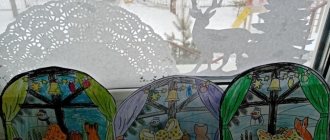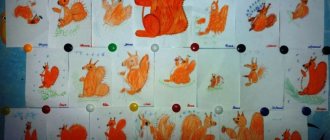Summary of a lesson on moral and patriotic education in the preparatory group of a preschool educational institution
Summary of a lesson on moral and patriotic education in the preparatory school group “Journey to the world of samovars”
Educator: Kazakova N.S., MADOU “Kindergarten No. 79”, Saratov. Integration of educational areas: “Game”, “Socialization”, “Communication”, “Reading fiction”, “Artistic creativity”, “Cognition”, “Speech development”. Tasks and goals: - To cultivate interest in Russian history.
— To interest children in the origin of the samovar in Rus'. — Formation of initial patriotic feelings. - Develop attention, thinking, ability to analyze, generalize, draw conclusions. — Remember new words and concepts. Previous work: - Examination of illustrations on the topic of GCD. -Looking at antiques. Final work: Visit to the unique museum of samovars. Materials for the lesson: Illustrations on the topic of GCD, presentation, samovar, coins. PROGRESS OF THE CLASS:
Children play on the rug. Educator: (addresses the children) Guys, I hear some sound. And you hear something unusual. (in the tape recorder the recording of the fly's buzzing gradually increases) children's answers: Yes, we hear the sound. (children express their assumptions) Educator: Guys, let's stand around and listen. Educator: Yes, guys, you're right, it's a fly. Why do you think we hear her? Children: Express their opinion Educator: Guys, let's try to reproduce this sound, maybe the secret will be revealed! We take in our breath and as we exhale we say z-z-z. First quietly, then louder and at the end quieter again, take our time. (2 times). Well done boys! Educator: Guys, look around, nothing has changed in the group. (The guys find a box in a natural corner, open it, and there is a letter and an object) Educator: Guys, let me help you read the letter. Letter: “Hello guys! There is an item (coins) in the chest. Guess what my name is? And why do I need coins? Children: Fly-Tsokotukha. You need coins to buy a samovar. Educator: Guys, do you remember who wrote this fairy tale? Children: This fairy tale was written by Korney Ivanovich Chukovsky Educator: Korney Ivanovich Chukovsky wrote this fairy tale correctly. (a character image appears on the m/m) Educator: Well done, let's sit down and listen to the story. (Children sit in a semicircle on chairs) Educator: Guys, you know what a samovar is and what it is needed for. (Children give their answers) Educator: A samovar is a device for boiling water and making tea. Now we put the kettle on the gas stove or, if it’s electric, we just turn it on. And before in Rus' there was nothing like this. Water was poured into a teapot, glass or cup exclusively from a samovar. And they sometimes spent several hours drinking tea. Drinking 5-6 cups of this aromatic drink, eating it with sweets, painted gingerbread cookies and bagels, was in the order of things. The whole country drank tea from the samovar. But most of all it was used in merchant families. Actually, they just say “cups,” but in fact, basically, according to Russian tradition, they drank tea from saucers. It was not customary to add sugar to tea. They were usually used as a bite. When someone finished drinking tea, they turned the saucer or cup upside down and put the remaining sugar on top. Pot-bellied samovars were used both in the homes of ordinary people and in the royal palace. (On the m/m royal samovar) This device was very convenient. Firstly, the water in the samovar boiled very quickly and cooled slowly. Secondly, at the top of the device there was a special place for the teapot, which also thanks to this did not cool down for a long time. And thirdly, the samovar seemed to attract everyone to the common table; it was very convenient to have leisurely, intimate conversations next to it. (On the m/m merchant samovar)
The samovar has been a symbol of the Russian feast for so long that many consider this invention to be Russian. In fact, devices vaguely reminiscent of a samovar were used by the ancient Romans. But most of all, a modern samovar is similar to an ancient Chinese device, which has both a pipe and a blower. (On m/m Chinese samovar)
Peter the Great, who traveled a lot around the world, often brought something new to Russia, previously unknown in our country. It was under him that the Russian people learned, for example, about the existence of potatoes and sunflowers. Thanks to him, a samovar, delivered from Holland, appeared, which was called a “tea machine” in Europe. Educator: Guys, I offer you finger exercises. One, two, three, four, (alternating clapping hands and hitting fists against each other) We washed the dishes: (one palm slides over the other in a circle) Teapot, cup, ladle, spoon And a large ladle. (bend your fingers one at a time, starting with the thumb) We just broke the cup, the ladle also fell apart, the nose of the teapot was knocked off. We broke the spoon a little. (extend your fingers one at a time, starting with the thumb) This is how we helped mom! (bump your fists together, clap your hands). And the very first Russian samovar was made of copper in 1739 in the Urals. But very few of them were produced there. The first workshop in the country, which was engaged only in the manufacture of samovars, was organized in the city of Tula in 1778 by the mechanic Lisitsyn. (On the m/m Tula samovar) Soon the need for “tea machines” reached such proportions that similar production facilities opened in many cities of Russia. It was only later that a single definition of “samovar” appeared, but at first it was called differently: in Kursk it was “samokipets”, in Yaroslavl - “samogar”, in Vyatka - “samogrey”. It is interesting that for some time so-called kitchen samovars were also produced in Russia. Inside they were divided into three parts by partitions. In two of them food was cooked, and in the third water was boiled for tea. (On the m/m samovar-kitchen)
At that time you could buy a samovar designed for one glass of tea, or you could buy one that could hold 50 liters of water. Copper ones were replaced over time by samovars made of an alloy of zinc and copper. You could also buy silver or nickel plated ones, but they were much more expensive. The world's largest samovar was made in Ukraine. Its height is almost 2 meters, it weighs 205 kg, and holds 360 liters of water. (On the m/m giant samovar)
The smallest samovar on our planet was made in Moscow. Its height is less than four millimeters. And you can boil only one drop of water in it. (On m/m the smallest samovar in the world)
There are not so many “tea machine” lovers left now. And they, in general, prefer not to bother with kindling, but to purchase electric samovars. They are also sold as souvenirs, reminiscent of an ancient Russian ritual - leisurely tea drinking with pies and jam. Physical education lesson: I am a teapot - a grumbler. I am a teapot - a grumbler, a busybody, a madman, (We walk in place.) I expose my stomach to everyone, (Hands on the belt, turns the body left and right.) I boil the tea, bubbling and shouting: (We clap in hands.) - Hey, people, I want to drink tea with you! (Jumping in place.) Educator: Guys, let's learn proverbs about the samovar together. YOU DRINK TEA AND YOU WILL LIVE TO BE A HUNDRED YEARS. The samovar is boiling and doesn’t tell me to leave. We don’t miss drinking tea – we drink six cups each. Educator: And now I suggest the guys go to the tables and make a samovar (the teacher explains the technique).
Educator: Well done guys! You did a good job! For such good work, tomorrow you are invited to visit the “Museum of Samovars”.
We recommend watching:
Integrated lesson in the preparatory group “Travelling the Islands” Summary of the joint activity of the teacher with the children of the preparatory group Summary of the joint activity of the teacher with the children of the preparatory group “Magic massage points” Summary of the joint activity of the teacher with the children of the preparatory group “Clever and wise guys”
Similar articles:
Summary of a lesson in decorative and applied arts in the preparatory group
Summary of speech therapy classes in the preparatory group
Lesson summary for older preschoolers on the topic: Transport
Summary of GCD in the preparatory group on the topic “Creation of the book “We are Olympians!”
Summary of a lesson on designing from waste material in the preparatory group


